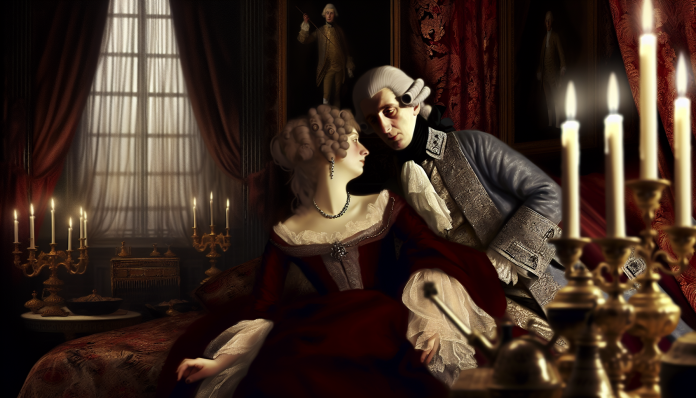Introduction
Queen Victoria, a monarch who reigned over the British Empire from 1837 to 1901, is often synonymous with the term “Victorian morality,” a period marked by strict social codes, prudishness, and a notable emphasis on family values. However, hidden beneath this facade of decorum were steamy love letters exchanged between Victoria and her beloved husband, Prince Albert, that would shock the sensibilities of her contemporaries—and even modern audiences. This article delves into the passionate correspondence of a royal couple, challenging our perceptions of their public personas and exploring the implications of their intimate expressions of love against the backdrop of their time.
The Scandal
The Context of Love Letters
Queen Victoria and Prince Albert married in 1840, a union that was much more than a mere political alliance. Despite their royal status, the couple shared an intense love affair that grew and blossomed through their years of marriage. The depth of their connection can be gleaned from a series of passionate letters they exchanged throughout their lives.
In these letters, Queen Victoria expressed her feelings with fervor. She wrote of longing and desire, describing Albert in terms that would make any modern romantic novelist blush. For instance, she described how she missed him while he was away and how intercourse was both a duty and a delight—a candid admission given the era’s strict standards regarding sexuality.
Key Quotes:
- “I feel so utterly alone when you are away… My heart is yours, and my body longs for your touch.”
- “You are my beloved. To think of you is like a sweet, seductive fire coursing through my veins.”
The Public Reaction
Despite their vibrant private life, Victoria and Albert were subject to societal expectations of virtue and propriety. The Victorian era was characterized by its stringent sexual mores, where any suggestion of sexual impropriety could ruin reputations or scandalize society. While their letters remained largely private during their lifetimes, the public was quick to judge any straying from moral expectations.
When their letters were later published in the 20th century, they ignited something of a scandal, offering a glimpse of a heartwarming and passionate relationship that contrasted starkly with the public personas of both the Queen and Prince. The outpouring of affection in their letters was at odds with Victorian ideals, which could lead to unexpected reactions:
- Shock: Many readers were astonished to learn that the seemingly stern and restrained Queen Victoria had such a passionate side.
- Admiration: Others respected the couple’s commitment to love and fidelity in a world where royal affairs were common.
Moral and Cultural Analysis
The Societal Reaction of the Time
While the public reaction to Victoria’s love letters was marked by a mix of shock and curiosity, the responses also revealed the prevailing machismo of Victorian society, where women were expected to embody virtue and chastity, while men were granted license to explore their desires. Queen Victoria’s candidness in her expressions of longing was refreshing yet troubling to many, challenging the expectations of female propriety.
- Consequences and Reactions:
- In stark contrast to modern expectations of open relationships and sexual freedom, the letters posed a danger to both royal integrity and public perception.
- Scandals involving closeted affairs, especially those of aristocrats, often ended poorly, leading to exile or significant damage to reputations. In this context, the Queen’s private passion had to remain just that—private.
A Modern Perspective
Fast forward to today, when liberal values have transformed societal norms around intimacy and public expression of love. The once-aristocratic cloak of propriety that shrouded sexual relationships no longer holds the same weight. A modern audience would likely appreciate Queen Victoria’s letters not only as a historical curiosity but as a reflection of universal human emotions—love, longing, and desire—regardless of the societal limitations imposed upon them.
- Comparison with Modern Moral Standards:
- Today, love letters—especially those shared between a couple—are celebrated as acts of affection and vulnerability. The vulnerabilities exposed in Victoria’s letters would likely be deemed beautiful and relatable rather than scandalous.
- Discussions surrounding sex and committed relationships have shifted drastically; sexual expression, even among public figures, is generally embraced rather than shunned.
Conclusion
Queen Victoria’s love letters to Prince Albert underscore the juxtaposition between the passionate realities of romantic love and the societal constraints of her time. What emerges from these correspondence is a portrait of a woman who defied her public persona, revealing the complexities behind the rigid moral fabric of Victorian life.
As we reflect on this historical scandal, it invites us to consider the ongoing evolution of societal attitudes toward sex, power, and personal freedom. The taboo and tension observed in Queen Victoria’s heartfelt expressions serve as a reminder: love transcends time, and the evolving perceptions of intimacy reveal just how far we’ve come in understanding human relationships.
Takeaway
As we navigate the complex web of relationships in today’s world, Queen Victoria’s story encourages us to ponder the progress we’ve made in liberating love from the shackles of scrutiny. In this modern age of transparency, honesty in love letters—steamy or not—may indeed stand as a testament to the authenticity we cherish in human connection.
Thus, as we leave behind the remnants of past moral standards, we can cherish the idea that love, in all its forms, remains an essential part of the human experience—a historical thread woven intricately through time, guiding our evolving attitudes towards intimacy and relationships.

